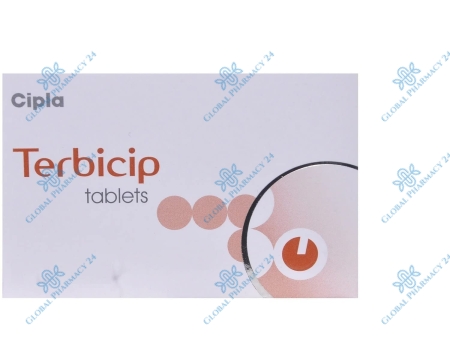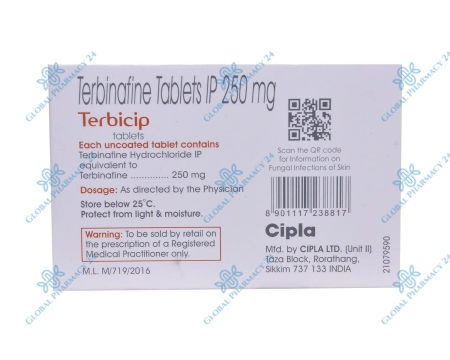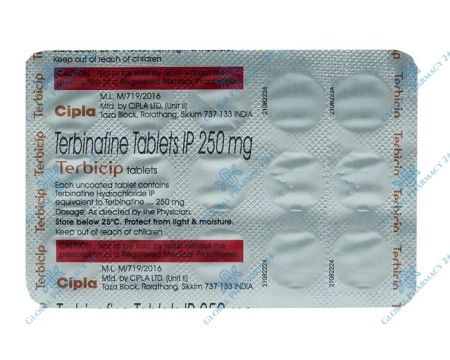| Attribute | Details |
|---|---|
| Active Ingredient | Terbinafine |
| Indications | Fungal Infections of the Skin and Nails |
| Dosage Form | Tablets, Cream |
| Duration of Treatment | Varies by Infection Site; typically 2-4 weeks for skin, 6-12 weeks for nails |
| Side Effects | Headache, Diarrhea, Itching, Rash |
| Benefits | Highly effective, Targets a wide range of fungal pathogens, Generic availability |
Explore Terbicip: A Revolution in Fungal Infection Treatment
Terbicip stands at the forefront of antifungal therapy, offering a potent solution against a broad spectrum of fungal infections. Its active ingredient, Terbinafine, targets the cell membrane of fungi, leading to their elimination. This mechanism of action not only ensures rapid relief from symptoms but also promotes complete recovery from infections, including those affecting the skin and nails. The availability of Terbicip in various formulations, such as tablets and cream, makes it a versatile option for patients seeking effective treatment.
As a generic counterpart to the well-known brand Lamisil, Terbicip presents a cost-effective alternative without compromising on efficacy. Its role in treating fungal infections has been validated by numerous studies, positioning it as a reliable and accessible choice for healthcare providers and patients alike. The introduction of Terbicip has significantly improved the management of fungal infections, offering a combination of affordability, effectiveness, and convenience that aligns with the needs of a diverse patient population.
Terbicip’s Role in Fighting Fungal Infections
Terbicip's efficacy in combating fungal infections lies in its active component, Terbinafine, which interrupts the growth of fungi by inhibiting their ability to synthesize ergosterol, an essential component of fungal cell membranes. This disruption not only halts the spread of the infection but also leads to the death of the fungal cells, effectively eradicating the infection. Terbicip is particularly potent against dermatophytes, yeasts, and certain molds, making it a comprehensive treatment solution for a wide array of fungal infections.
Terbinafine: The Core Ingredient and Its Effectiveness
Terbinafine, the heart of Terbicip's formulation, offers a targeted approach to fungal eradication. By selectively inhibiting the enzyme squalene epoxidase, Terbinafine disrupts fungal cell wall synthesis without affecting human cells. This specificity not only enhances its antifungal potency but also minimizes the risk of side effects, making Terbicip a preferred choice for long-term treatment of fungal infections.
The Value of Generic Medication: Spotlight on Terbicip
The introduction of Terbicip as a generic medication has transformed the accessibility of antifungal treatments. Generic drugs, offering the same therapeutic benefits as their branded counterparts, significantly reduce the financial burden on patients. Terbicip, with its proven efficacy and lower cost, exemplifies the critical role of generic medications in expanding access to essential treatments, ensuring that effective healthcare solutions are within reach of a broader audience.
A Side-by-Side Look at Terbicip and Lamisil: Efficacy and Affordability (Comparison Table Included)
| Attribute | Terbicip | Lamisil |
|---|---|---|
| Active Ingredient | Terbinafine | Terbinafine |
| Efficacy | Comparable | Comparable |
| Cost | Lower | Higher |
| Availability | Wide | Wide |
Getting Your Hands on Terbicip: A Step-by-Step Guide
Purchasing Terbicip has been made straightforward in the digital age, with multiple platforms offering the medication online. Patients can easily find Terbicip through reputable online pharmacies, ensuring they receive authentic medication directly to their doorstep. The process usually involves a simple verification of the prescription, a secure payment gateway, and a confidential delivery system. This convenience has enabled patients to access Terbicip without the hassle of traditional pharmacy visits, simplifying the treatment journey for fungal infections.
However, navigating the world of online medication orders requires a cautious approach. It's crucial to verify the legitimacy of the pharmacy, the authenticity of the medication, and the security of the transaction. Patients are advised to conduct thorough research, read reviews, and possibly consult healthcare professionals before making an online purchase. This vigilance ensures not only the effectiveness of the treatment but also the safety and privacy of the patient.
Navigating the World of Online Medication Orders
Ordering Terbicip online offers a blend of convenience and efficiency, allowing patients to manage their treatment with ease. Reputable online pharmacies provide detailed information about the medication, including usage instructions, potential side effects, and contraindications, ensuring patients are well-informed before making a purchase. This model of care encourages patient autonomy and informed decision-making, hallmarking a new era in healthcare accessibility.
Common Queries about Personal Medication Imports Answered
When it comes to importing medications like Terbicip for personal use, patients often have questions regarding legality, safety, and the process involved. Key points include ensuring the source is reputable, understanding the legal quantity limits, and the importance of having a valid prescription. Consulting with healthcare professionals and referring to official resources can provide clarity and confidence in the importation process, facilitating access to necessary treatments while adhering to regulatory requirements.
Using Terbicip: A Comprehensive Manual
Terbicip's effectiveness in treating fungal infections is maximized when used according to prescribed guidelines. The treatment regimen varies depending on the infection's location and severity, with oral tablets typically used for nail infections and topical formulations for skin infections. Adherence to the prescribed duration of treatment is crucial to ensure the complete eradication of the fungal infection and to prevent recurrence. Patients should start noticing improvements within a few weeks of consistent use, although the full course of treatment should be completed for optimal results.
Understanding the specifics of the Terbicip treatment regimen is essential for achieving the desired outcomes. This includes not only the correct dosage and duration but also the proper method of application for topical forms. For instance, the cream should be applied to clean, dry skin to facilitate absorption. Additionally, patients are advised to maintain good hygiene practices and follow any lifestyle or dietary recommendations provided by their healthcare provider to support the effectiveness of the treatment.
Guiding You Through Dosage and Treatment Duration
The dosage and duration of Terbicip treatment are determined based on the type and severity of the fungal infection. For nail infections, oral Terbicip is typically prescribed for 6 to 12 weeks, while skin infections may require 2 to 4 weeks of topical application. It's important for patients to follow their healthcare provider's instructions closely and to complete the full course of treatment even if symptoms improve early, to ensure the infection is fully eradicated.
Knowing Your Course: Mapping Your Antifungal Journey
Embarking on a treatment journey with Terbicip involves a clear understanding of the course ahead. This includes recognizing the duration of treatment as a commitment to health, adhering to dosage instructions, and being prepared for the gradual improvement of symptoms. Regular consultations with healthcare professionals can help adjust the treatment plan if necessary and provide support throughout the recovery process.
Use with Caution: Important Safety Information about Terbicip
While Terbicip is highly effective in treating fungal infections, it's important for patients to be aware of safety information and potential side effects. Patients with liver or kidney problems, immune system issues, or a history of allergic reactions to antifungal medications should discuss their conditions with a healthcare provider before starting Terbicip. Adherence to safety guidelines ensures not only the effectiveness of the treatment but also the well-being of the patient.
Special Considerations: Who Needs Extra Care?
Certain populations require special consideration when using Terbicip, including pregnant or breastfeeding women, the elderly, and individuals with pre-existing liver or kidney conditions. A healthcare provider may recommend monitoring or adjust the dosage accordingly to accommodate these special needs, ensuring the safe and effective use of Terbicip.
Weighing Pros and Cons: The Benefits and Drawbacks of Terbicip
- Pros:
- High efficacy in treating a wide range of fungal infections
- Available in both oral and topical formulations
- Generic option available, making it more affordable
- Generally well-tolerated with a low incidence of side effects
- Cons:
- Potential for liver-related side effects, requiring monitoring
- May interact with other medications
- Not suitable for all populations, such as those with certain pre-existing conditions
- Requires prescription, limiting over-the-counter access
Side Effects and Interactions: The Need-to-Knows of Terbicip
While Terbicip is an effective treatment for fungal infections, like all medications, it comes with the potential for side effects and interactions. Common side effects include headache, gastrointestinal disturbances, skin rash, and, rarely, changes in liver function. These effects are generally mild and transient, but patients should report any persistent or severe symptoms to their healthcare provider.
Interactions between Terbicip and other medications can affect the efficacy and safety of treatment. It is crucial for patients to inform their healthcare providers about all medications they are taking, including over-the-counter drugs and herbal supplements. This allows for the identification of potential interactions and the adjustment of treatment plans as necessary to ensure the safe and effective use of Terbicip.
Common and Uncommon Side Effects of Terbicip
The most commonly observed side effects of Terbicip include gastrointestinal issues, such as nausea and diarrhea, skin reactions like itching and rash, and headaches. These side effects are typically mild and resolve without the need for discontinuation of treatment. However, patients experiencing severe or persistent symptoms should seek medical advice.
Potential Serious Side Effects: Staying Informed
Although rare, Terbicip can cause serious side effects, including liver damage, severe skin reactions, and allergic reactions. Awareness and prompt reporting of any unusual symptoms, such as jaundice, severe skin rashes, or difficulty breathing, are critical for early detection and management of these potential risks.
Contraindications and Drug Interactions: Navigating the Landscape
Terbicip is contraindicated in patients with chronic liver or kidney disease, and caution is advised when used in conjunction with certain medications, such as antidepressants, beta-blockers, and other antifungals. A comprehensive review of a patient's medication history is essential to prevent adverse drug interactions and to tailor the treatment plan to the individual's needs.
FAQs Terbicip
What is Terbicip used for?
Terbicip is used to treat fungal infections of the skin, such as athlete's foot (tinea pedis), jock itch (tinea cruris), and ringworm (tinea corporis).
How does Terbicip work?
Terbicip contains the active ingredient terbinafine, which works by killing the fungi causing the infection. It does this by inhibiting the enzyme necessary for fungal cell wall synthesis, leading to the death of the fungi.
How should I use Terbicip?
Apply a thin layer of Terbicip cream or gel to the affected area and gently massage it into the skin. Wash your hands before and after applying the medication. Use Terbicip exactly as directed by your doctor or as instructed on the label.
What are the possible side effects of Terbicip?
Common side effects of Terbicip include itching, burning, irritation, redness, or dryness at the application site. These side effects are usually mild and temporary. However, if you experience severe or persistent side effects, contact your doctor.

























